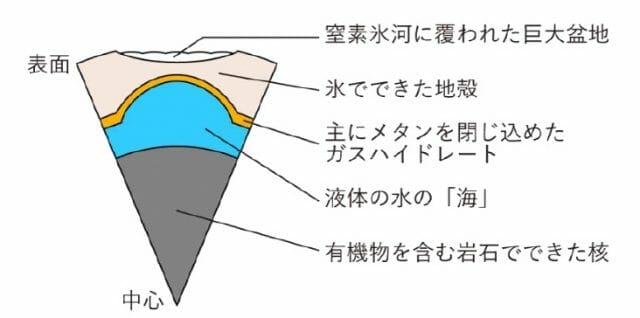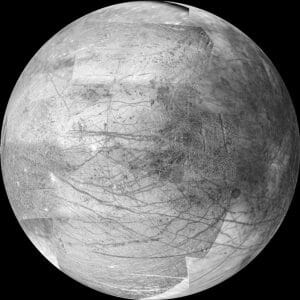Image of Jupiter’s moon Europa. Taken by NASA’s Jupiter spacecraft Galileo. (Credit: NASA / JPL / University of Arizona)
Okayama University announced on December 23 that it has developed a method to theoretically and accurately predict whether ice or gas hydrate will occur in the presence of water and gas under cryogenic or low pressure conditions. did. The research team actually applied this method to the satellites of the outer planets and Pluto, and succeeded in theoretically clarifying the state of ice on the surface and inside.
Water either evaporates or exists in the form of ice in outer space.
And a line in the star system where water can exist as ice far enough from the starSnow lineIt’s called. In the solar system, the snow line is between Mars and Jupiter, near the asteroid belt.
A large amount of ice exists on planets and their satellites outside this snow line because water can exist in the state of ice.
By the way, when water and gas such as methane and nitrogen are present at the same time on the outer planets, their satellites, Pluto, etc.Gas hydrateHowever, it was not well understood under what conditions gas hydrate would occur. By the way, gas hydrate is “ice that takes in gases such as methane and nitrogen” and has excellent heat insulation.
Therefore, the research team has developed a method to theoretically and accurately predict under what temperature, pressure, composition ratio (composition ratio of gas and water), etc., gas hydrate will occur. Then, by applying this method, we investigated the state of ice that could exist on the satellites of the outer planets, Pluto, and so on.
Then, it turns out that ordinary ice is formed when dilute oxygen atmosphere and water exist at the same time, such as Jupiter’s moons Europa and Ganimede. It has been found that ordinary ice cannot be produced on low Pluto, but only gas hydrate containing nitrogen and methane can be produced.
Among theseOf particular note is Plutois.On Pluto, the decay heat of the radioactive material contained in the core melts the ice and makes it thicker.There is a vast inner sea under the ice crustIs believed to be.
However, I was not sure why the inner sea did not freeze on Pluto, which is extremely cold.
However, in 2019, if a research team such as Hokkaido University has a layer of gas hydrate between the inner sea of Pluto and the crust of ice, the inner sea will not freeze due to the heat insulating effect of the layer of gas hydrate. We are announcing the idea that there is a possibility. According to the research team, the results of this research strongly support this idea of the research team at Hokkaido University.
Perhaps there is some kind of life in the inner sea of Pluto, protected by a layer of gas hydrate.

An illustration that explains the ideas of research teams such as Hokkaido University in an easy-to-understand manner. Gas hydrate has excellent heat insulating properties. (Image Credit: Hokkaido University)
Image Credit: NASA / JPL / University of Arizona / Hokkaido University
Source: Okayama University
Sentence / Shigeyuki Iido
Related article link (external site)
The young appearance of the galaxy may be “tadpole-shaped”
Spacecraft Juno captures Jupiter’s “Abyss”
An unlucky star torn close to the black hole of “NGC 1589”



